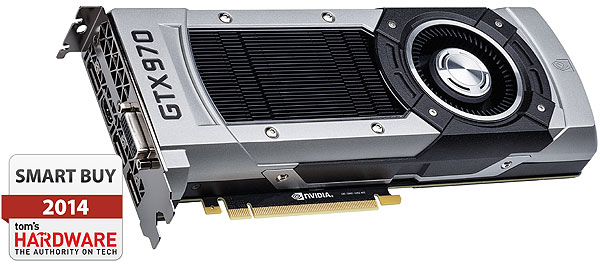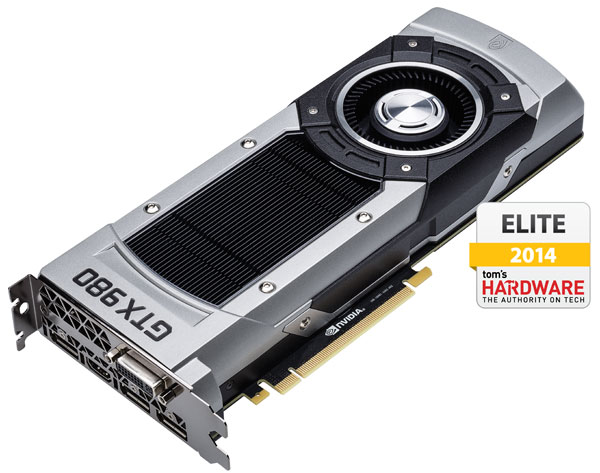Nvidia GeForce GTX 970 And 980 Review: Maximum Maxwell
Verdict
If you've skipped to the last page to see our conclusion, I'm not going to waste your time: both the $330 GeForce GTX 970 and $550 GeForce GTX 980 represent tremendous, earth shattering value from a price/performance perspective. But don't take my word for it, have a look at the following charts that represent the average performance we recorded from these cards:
The GeForce GTX 980 not only sets a high-water mark for single GPU performance, but at $550 it does the trick for $50 less than the GeForce GTX 780 Ti costs at e-tail. That's a mere $70 more than the Radeon R9 290X, by the way. There are two important implications with this product: first, that a dual-GPU setup is no longer the only viable path to playability on 4K monitors. Second, the fastest single-GPU graphics card can now be purchased under $600. That's significantly cheaper than the $1050 GeForce Titan Black, the previous title holder.
As for the GeForce GTX 970, it may not bring performance to a new level, but its price definitely makes high-end performance more accessible. At $330 it delivers frame rates comparable to the Radeon R9 290X, a card that currently sells for an average price of about $170 more. We did not expect to see a product this potent at a price tier significantly below the $400 Radeon R9 290, which has suddenly become less appealing.
Nvidia, you had us at the price/performance ratio. But you didn't stop there: the power draw is very low when you consider the performance these cards deliver in return. Anti-aliasing features such as Dynamic Super Resolution (DSR) and Multi-Frame Sampled Anti-Aliasing (MFAA) promise to increase visual fidelity and increase the frame rate, respectively, in a manner completely transparent to the games we play. The point is that we can enjoy these features without relying on developers to implement them on a per-game basis, and that is a good thing. In addition, the technologies under the company's VR Direct initiative speak directly to the virtual reality enthusiast in us, and we can't wait to try them out. As for Maxwell's ability to handle Voxel Global Illumination (VXGI), we think it's a valuable step toward photo realism in games. On a final note, it goes without saying that DirectX 12 compatibility is a desirable feature from a long-term perspective.
Of course, nothing is perfect. The GeForce GTX 980 might be the fastest graphics card on the planet with a solitary GPU onboard, but you're still going to have to lower detail settings most of the time in order to make 3640x2160 a playable resolution. In addition, our expert Igor Wallossek has some insights into the GeForce GTX 970 and 980's power draw as he found micro-spikes and load scenarios that draw significantly more than the TDP these cards are rated for. As for features, we couldn't test MFAA as it isn't yet implemented in the GeForce driver. At this point we're taking Nvidia's word that this new anti-aliasing method will be as effective, efficient, and backward compatible as the company suggests. We weren't even able to test DSR to our satisfaction thanks to the late arrival of our sample cards. Finally, as promising as VXGI may be, we're extremely skeptical that this generation of hardware is powerful enough to handle meaningful real-time voxel cone tracing in a modern game with complex geometry.
But the beauty of the GeForce GTX 980 and 970 is that, regardless of any minor annoyances, they have got it where it counts: higher frame rates for significantly less cash than we're used to paying. That's a formula that speaks directly to our gamer hearts, and inspires us to award both of Nvidia's new graphics cards with the highest appropriate honors. For the GeForce GTX 980 we bestow Tom's Hardware's Elite award, stealing the prized mantle-piece (pardon the pun) from the Radeon R9 290X. As for the GeForce GTX 970, Tom's Hardware's Smart buy award is a perfect fit for this card, which provides strong performance for an incredible value. It may have taken a while to get here, but the second-generation Maxwell GPU was worth the wait.
Get Tom's Hardware's best news and in-depth reviews, straight to your inbox.
Don Woligroski was a former senior hardware editor for Tom's Hardware. He has covered a wide range of PC hardware topics, including CPUs, GPUs, system building, and emerging technologies.
-
lancear15 I was waiting for Tom's review to make my final decision, the 980 is definitely going into my current 5960x build! I cant wait.Reply -
HKILLER so how long before you do a round up?i mean this time i've seen some pretty crazy looking cards (Zotac's Extreme AMP! edition looks crazy and the Inno3D too)and EVGA has shown off ACX 2.0 which they claim to be the most efficient GPU air cooler in the world...so many to choose from also EVGA FTW has been nicely overclocked i've seen it performing almost on par with 980Reply -
realibrad byt he way... Last page 2nd sentence after the graph of Avg game performance.Reply
I was hoping for more performance but the efficiency is quite nice. They just put pressure on the top end and gave us a price reduction, instead of overall performance gains. -
balister Very nice, but I still want to see what the power consumption along with what might be possible with the drop to 20nm (since this is still 28nm).Reply
Likely, we're going to see a Maxwell Titan equivalent come in the next year or so as these are a x04 much like Kepler with the 670/80s were and we're still going to be waiting to see what the x10 will be with the Maxwell architecture. -
MANOFKRYPTONAK Why didn't you include an overclocking comparison? Why didn't you include the 780, but included the 770? Doesn't make much sense...Reply -
vertexx 970 is the real story until the 980ti comes out - what a value proposition with the 970!Reply
Good stuff here - but you guys were a bit slow on this one. Tom's Hardware is the first site I visit every morning. But with the delay of this article, I've been all over the net this morning on other sites that got their stuff out sooner. -
daveys93 Will there be a follow-up article about overclocking these cards? Other sites are showing results that both of the new cards are capable of 1500+ MHz on air (aftermarket coolers and even a few with stock coolers), which is a massive overclock. Looks like NVIDIA left the door open for some decent voltage increases, but many results have been in the 1450-1500 MHz range at stock voltage. I am a big fan of the thoroughness of Tom's articles so I am very interested in seeing overclocking results and analysis from this site.Reply



